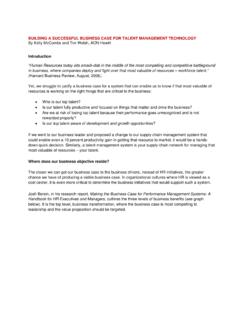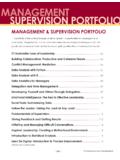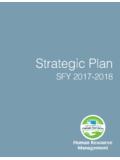Transcription of Feature - IHRIM Publications
1 4 April/May 2013 Workforce Solutions Review Workforce Planning is Quietly Transforming HRBy Ray J. Rivera, SAP Labs, LLC and Frans Smolders, SAP AGLeaders need to put their money where their mouth is and get HR to do its real job: elevating employee manage-ment to the same level of professionalism and integrity as financial management. Since people are the whole game, what could be more important? 1 Jack Welch, former chairman and CEO, General ElectricOverview Top-performing businesses recognize that insights they can extract from their own data are crucial to maintain-ing competitive Some of their most important insights involve the dynamics of their workforces, and the capacity to adapt Yet, many companies are be-coming much more complex: teams are distributed world-wide, alliances involve numerous partners, and production requires coordinating specialized skills globally. The need for managers to know their workforces has never been greater, and deciding how to staff these complex business functions relies on better evidence of what really drives Workforce planning represents a major transforma-tion of the role and competencies of HR, making it a driver of business growth and operational efficiency throughout the enterprise.
2 In this article, we will show how an opera-tional approach to workforce planning contributes to both, and how it makes HR a more effective business partner. What is Operational Workforce Planning?At its core, operational workforce planning (or, opera-tional head count planning) is a matter of matching supply and demand, subject to financial In practice, it is a business process aimed at maximizing the contribu-tions and productivity of labor inputs in the short- to medi-um-term, according to specific organizational goals that in turn are informed by corporate Operational workforce planning has three components: (1) mapping the employee skills, knowledge, capabilities, and competencies to job profiles; (2) allocation of head count across an entire organization; and (3) analysis of the gap between desired and actual head as a business process, operational work-force planning should be conducted in a manner similar to corporate budgeting, and can be broken down into four sequential steps: preparation, planning, consolidation, and execution.
3 Likewise, operational workforce planning involves a considerable amount of data analysis and effec-tive transmission of information across business units and levels of management, both of which are critical in creating a successful final Preparation The first objective is to provide regional and local management with clear insights into the workforce so that correct assumptions can be made, and questionable ones get challenged and refined. The first task involves budget preparation, where current personnel costs are obtained, and head count evolvement assumptions are assembled. Next, a preliminary budget proposal is created based on assumptions and cost drivers. Human Resources may perform these tasks independently or, more commonly, in consultation with Finance. At this point, the Budgeting and Controlling function often sets up guidelines to align bud-geting layers, and all participating managers are typically provided with prefilled head count planning PlanningThe next step, planning, can be characterized by the three words: assess, simulate and plan.
4 Here, managers make head count proposals based on the most reliable and accurate figures they can determine. It begins by analyz-ing the current workforce, based on prefilled templates and, in some cases, reviewing promotions, leavers, retire-ments and other separations. In many large organizations, Feature Workforce Solutions Review April/May 2013 5 there is enough information to create workforce scenarios. What-if scenarios are often performed to optimize head count proposals, and initial guidelines are obtained to model head count forecasts. In many cases, such scenarios are performed extemporaneously, either in one s head or using a key objective of the planning step is for line managers to obtain budget insight that illustrates the consequences their actions might bring about. While the budget, both head count and salary, emerges from a top-down demand planning process, a line manager usually has some latitude in judging the most appropriate ways to apply the budget within his or her business unit.
5 By commenting, the man-ager can apprise senior management of the scope of his or her part of the organization. Later, during the consolidation stage, when top-down demand planning and bottom-up supply planning be-come aligned, the line manager s commentary can provide valuable insight for senior management in determining whether the strategy they have laid out is also executable by middle ConsolidationThe previous step, planning, usually generates numer-ous documents, and so it is important to consolidate the results. During the consolidation step, the results of all business units operational head count plans are con-densed into a dataset that, ideally, can be entered directly into the enterprise financial planning system. Consolida-tion usually requires additional software support when managing complex transactions such as calculations using multiple currencies, inter-group transfers and full-time equivalant allocations.
6 In most organizations, a computing infrastructure exists to perform this step by means of an automated roll-up. However, many organizations continue to do the roll-up manually, which increases the likelihood of introducing human error into the , even if the roll-up is automated, controllers must still monitor the process personally, keeping track of all business workflows, the assigned managers, and the bud-geting tasks. The result is a consolidated outcome, which in most organizations incorporates all departmental planning templates. The final roll-up becomes the proposal that is later submitted for finalization, which may be refined by additional iterations of cost drivers and assumptions ac-cording to overall corporate ExecutionThe final step is where assumptions are validated, as top executives review the plans, determine the planning policies, and set the direction. Top managers typically perform an additional analysis of the current workforce to assess and drill down to lower level management explana-tions in order to understand the complete picture.
7 Once satisfied with their analysis, they can decide on future head count. This step often serves to provide actionable insight by which to optimize head count decisions. And, in some cases, discover incorrect assumptions that need to be reas-sessed by the planning team before the plan is management can have significant influence on the final plan, along with the effectiveness by which it is communicated and carried out. High-quality, deliberate management can add refinements to workforce plans and direct resources needed for proper execution. Conversely, inadequately informed or impulsive management can over-rule solid plans, or interfere with the execution of other-wise well-formulated plans. Additionally, workforce plans that managers perceive as conflicting with shareholder demands or performance incentives are likely to be altered so as to align with those this final plan, workforce action plans and other management control systems are established.
8 Managerial control is the single most important means of maintaining alignment, as it provides mechanisms for systematic han-dling of performance information, consistent measurement of organizational behaviors, and managing by The scope of control systems in regular corporate budget-ing can stretch across the enterprise, and likewise for op-erational workforce planning. Workforce action plans are applied to areas such as business workforce plans, training and development programs, recruiting, promotions, as well as sourcing decisions such as contractor management, contingent workforce and partner Revising of the Ways HR becomes a Business EnablerAs a business enabler, HR can improve organizational performance by providing insight about the workforce to guide specific action. Furthermore, such insight must be forward-looking in order to deliver the value that HR has the potential to deliver. Specificity is critical, and as-sembling and allocating the workforce, particularly in the short- to medium-term is an area where analytics can help HR provide valuable forward looking insight.
9 Such insight is critical for business growth, which, for many organiza-tions, must proceed from better management of its sort of workforce management supports growth? Sustained growth companies tend to practice superior human capital management at a strategic level by shaping culture through leadership development and training, and retaining At a more operational level, companies noted for superior human capital management distinguish themselves in three ways: visibility of job roles critical to Senior management can have signifi-cant influence on the final plan, along with the effectiveness by which it is communicated and carried April/May 2013 Workforce Solutions Review success; integration of talent management and business data; and processes to identify gaps between workforce supply and business In short, busi-ness enablement for HR is characterized increasingly by applying the procedures and discipline of operational workforce planning to address the immediate concerns of growth and Business Value versus Cost ReductionSince the late 1980s, there has been a focus among HR leaders on strategic human resource The argument followed that in order to rise above the role of a cost center, HR needed to shift away from tending primar-ily to administrative tasks to becoming a partner in corpo-rate In many organizations, solutions such as automated salary and head count with integrated workflow, currency conversion, and consolidation were originally imple-mented with the aim of unburdening HR executives from tactical activities so they could devote more time to stra-tegic Ironically.
10 It is resulting in greater HR attention toward the enterprise-wide benefits of efficient operations within the HR function,14 particularly regarding the composition of the in data provisioning and visualization are mak-ing data more accessible across the organization and driving greater standardization. No longer hoping for a single metric that captures the enterprise value of the company s human capital, HR is using analytics to discover the unique prac-tices within their own organizations which drive increased performance,16 and the means to implement, measure, and monitor effective and efficient HR operations performance can represent a significant source of unlocked value. A 2010 study by MIT Sloan Management Review and the IBM Institute for Business Value found that top performing organiza-tions differentiate themselves by their use of analytics in the areas of workforce planning and allocation and risk In addition, top performing organizations were twice as likely to use analytics to guide daily opera-tions as lower performing organizations, and tended to use analytics to achieve desired operational behaviors rather than strategic outcomes.





